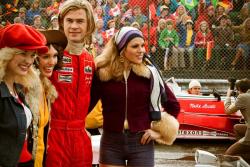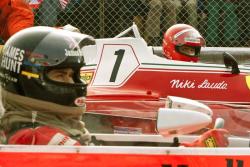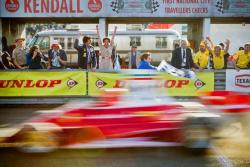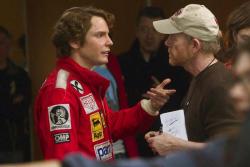Article by Brendan McAleer
Most of the time, we car reviewers are advising you how to spend thousands of dollars on something you’ll keep for years. Theoretically, it should be far easier to recommend spending twelve bucks for two hours entertainment – but this is not always the case (see: The Lone Ranger).
However, it is with great relief that I can inform you that Ron Howard’s F1 racing flick, Rush, lives up to all the internet buzz around it. It’s worth both your time and money, but before I explain why, if you’re going to see it anyway, stop reading here. Mild spoilers ahead.
 Movie Review: Rush. Click image to enlarge |
In a nutshell, the story hangs on two central characters, a dashing, devil-may-care hero and his calculating, offensive, seemingly inhuman rival. They could have called it, Captain Kirk and Mr. Spock go to the races. Halfway through, however, things are turned on their head and the audience finds themselves rooting for both men.
Chris Hemsworth, who everyone will recognize as Thor, plays lightning-fast lothario James Hunt with easy affability. Hunt’s notorious excesses are at first easy to forgive, but gradually Howard pulls the lens back and we see something of an emptiness amidst all the noise, a petulant childishness.
Brühl’s Lauda is instantly unlikeable, rat-faced and blunt of speech, but you warm to him gradually, as with all great villains. Lauda strategizes himself into a F1 driver’s seat, Hunt charms his way in.
The racing footage itself will not please everyone. F1 can often be a form of high-speed, high-stakes chess, with tension building over an entire weekend and season. Cramming all that into under two hours requires some distillation, and while much effort has been made to avoid clunky visual effects, you can’t make a movie like this without some green-screen trickery.
  Movie Review: Rush. Click image to enlarge |
What you get, instead of stark realism, is sheer excitement. V12 engines snarl, tires spin, tiny rocks ping off the drivers’ helmets, and all the while, there’s speed and sound in an incomprehensible wave. The danger is there, but you share a sense of exhilaration as the cars scream along, almost always shot from a very low angle.
Particularly during the dangerous F1 of the ’70s, death is always present at every race, and along with the joy of speed, we’re shown its disastrous after-effects: a corpse in a wrecked car, a brutal compound fracture. Hunt famously throws up before every race, a sea of roiling adrenaline; Lauda calculates his chances of dying at an acceptable 20 percent.
It’s Death that becomes the villain in the end. Lauda’s unwavering irascibility wins us over, and when he fights his way back from his horrific crash, you can’t help but cheer. Cheer for whom? Like the best movies, there’s no real bad guy, just a closely fought rivalry.
 Movie Review: Rush. Click image to enlarge |
Also of interest, during the off-track sessions, are all the period-correct cars that show up. From Lauda lecturing teammate Clay Regazzoni in a Ferrari 306 to the pair of Toyota Celica STs that show up at the Japanese Grand Prix, each backdrop car is perfectly chosen.
But, if you’re a racing historian, or are expecting a documentary, you won’t find perfection here. As in his other historical film, Apollo 13, Howard is taking fact and trimming, tightening, highlighting and downplaying elements of it until the story is fully exposed. In other words, he’s making a movie.
The good news is that you don’t have to know a thing about Formula One to thoroughly enjoy this neatly-crafted tale with just enough edge to be interesting. There’s a scene where Lauda supposedly displays his technical expertise, but you don’t need to hear the numbers, simply see the look on his face when his car is proved to be faster.
|
Related articles Official Movie Website
Photo Gallery: |
I was privileged enough to see a Formula One race in person, and while it’s a much safer sport than it used to be, the sound and fury of the cars is mind-boggling – the circus that surrounds the events, the celebrities, the endorsements, the parties and the crowds and all the money that goes into every event. And at the end of it all, they have a race, and for a tense two hours, you’re on the edge of your seat, watching the incredible athleticism and control at the pinnacle of motorsport.
Ron Howard spent millions making this movie, months and months of work, cutting, editing, building replicas of the cars, borrowing priceless originals, losing one in filming. The end of all this effort is two short hours of something special.
Like a race, it’s over all too soon. But like a good story, it stays with you.











